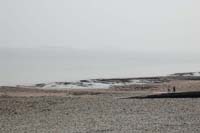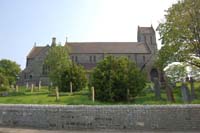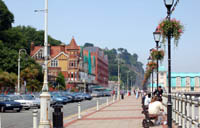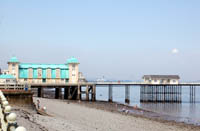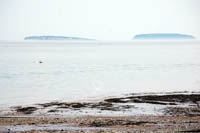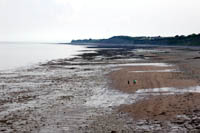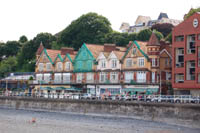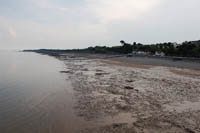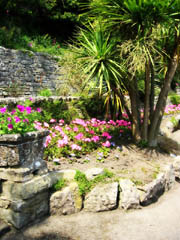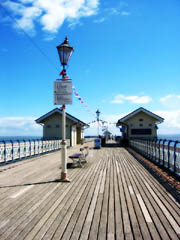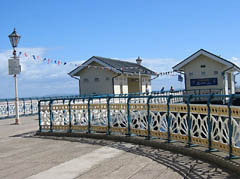Penarth (Welsh: pen head, + garth cliff or hill, or arth bear) is a town in the Vale of Glamorgan, Wales, lying on the Bristol Channel (or M�r Hafren) and Cardiff Bay. The town lies at the southern end of the Cardiff Bay Barrage, which it is possible to walk across (though access for pedestrians through the dockyards on the east end of the barrage is restricted). It is also situated near to the Welsh capital city of Cardiff. The title of the town is commonly misinterpreted to mean 'Bear's Head', the second part of the town's name proving problematic to translate for some, when in fact it means 'Clifftops', gaining its name from the cliffs running along the town's seafront. The town does however have a popular pub known as The Bear's Head.
Attractions in Penarth include Penarth Pier  , which is over one hundred years old and is (2005) in the process of being redeveloped, several art galleries, while both Cosmeston Medieval Village and Lavernock Point lie nearby. Due to its ideal location for commuters to travel into Cardiff, its picturesque scenery and Victorian style architecture in many older parts of the town, as well as the massive redevelopments taking place in nearby Cardiff Bay, Penarth has become a much sought-after area in South Wales, causing property values to soar. , which is over one hundred years old and is (2005) in the process of being redeveloped, several art galleries, while both Cosmeston Medieval Village and Lavernock Point lie nearby. Due to its ideal location for commuters to travel into Cardiff, its picturesque scenery and Victorian style architecture in many older parts of the town, as well as the massive redevelopments taking place in nearby Cardiff Bay, Penarth has become a much sought-after area in South Wales, causing property values to soar.
The town of Penarth owes its development to the massive expansion of the local coal industry in the 19th century. Its proximity to Cardiff, which was the natural outlet for the industrial valleys of Glamorgan, and its waterfront meant that it was ideally situated to meet the world demand for welsh coal through the construction of the docks. The contract for the building of Penarth Dock was placed in 1859 and the dock was opened six years later in 1865.
Over 200 years ago Penarth was little more than a village, being one of five parishes in the Hundred of Dinas Powys, with a combined population of just over 300.
By 1861 the number of people in the five parishes had increased to 1,898 and to 3,382 by 1871. In 1875 three of the parishes - Penarth, Cogan, and Llandough - were merged into the Penarth Local Board, giving a population of 6,228 persons by 1881. This figure had doubled by 1891 with the opening of the railway and had increased even further by 1901 to 14,228 persons.
The development of the town was rapid and Penarth soon became self-sufficient with its own local government, thriving shopping centre and community facilities. Many of the town's features owe their origin to the landowners of the time and the results of their vision can be seen by the many fine buildings and parks which make Penarth what it is today. Thanks to the generosity of these landowners, Penarth earned the reputation of "The Garden by the Sea" because of its beautiful parks and open spaces. Furthermore, many of the buildings and features of the town have led to a substantial part being designated as a Conservation Area because of its Victorian/Edwardian architecture.
The once-renowned Penarth Rugby Football Club is based at The Athletic Field, Lavernock Road, Penarth, where it used to host the world-famous Barbarians Football Club each Easter Good Friday, until 1986. This fixture was the start of the "Baa-Baas" annual South Wales tour, which also encompassed playing Cardiff on the Saturday, Swansea on Easter Monday and Newport on the Tuesday. Easter Sunday would see the Barbarians "playing" golf at the Glamorganshire Golf Club, in Penarth, while the former Esplanade Hotel, that was located on the seafront at Penarth would host the party for the trip, at their "spiritual home".
Alun Michael is the MP and Lorraine Barrett is the Welsh Assembly member for Cardiff South & Penarth. |


